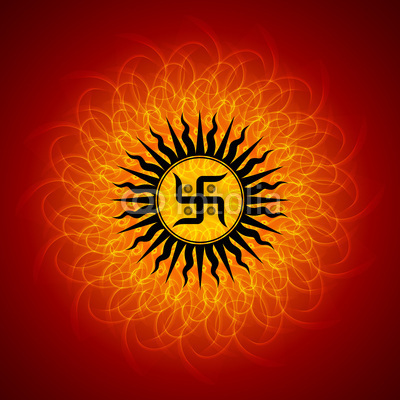The Swastika, a sacred and ancient symbol, holds profound significance in the Vedic and Upanishadic traditions of India. Far beyond its superficial use as a sign of auspiciousness, the Swastika represents a comprehensive cosmological, spiritual, and philosophical worldview rooted in the sacred texts of Hinduism. The etymology, geometry, and placement of the symbol encode essential truths about time, direction, creation, and the ultimate purpose of life.

Etymology and Meaning in Vedas
The word Swastika originates from Sanskrit:
“सु” (su) – meaning ‘good’ or ‘well’,
“अस्ति” (asti) – meaning ‘to be’,
“क” (ka) – a symbolic suffix.
Together, they form “Swasti”, which translates to “May it be auspicious” or “May there be well-being.”
The symbol appears in the context of Vedic peace invocations (Śānti Pāṭha) such as the following verse from the Rigveda and Mundaka Upanishad:
ऊँ स्वस्ति न इन्द्रो वृद्धश्रवाः स्वस्ति नः पूषा विश्ववेदः।
स्वस्ति नस्ताक्ष्र्यों अरिष्टनेमिः स्वस्ति नो बृहस्पतिर्दधातुः।।
This mantra invokes blessings from various deities for universal welfare, protection, and knowledge. Here, Swasti is not merely a word but a divine invocation woven into the liturgical rhythm of the Vedas.
Cosmological and Symbolic Aspects
The Swastika’s design—four arms bent at right angles—embodies cyclicality, direction, and balance. Its relevance extends across various natural and metaphysical systems:
1. Symbol of Cosmic Cycles
-
Represents the Sun, the eternal source of energy and life.
-
Embodies Kala (Time) and the cyclical flow of Yugas:
-
Satya Yuga, Treta Yuga, Dvapara Yuga, Kali Yuga.
-
2. Representation of Space and Nature
-
Denotes the four directions: North, South, East, West.
-
Symbolizes the four seasons: Spring, Summer, Autumn, Winter.
-
Believed to attract auspicious energies from all directions.
The Swastika and Vedic Structure
The Swastika is described in the scriptures as a symbolic representation of the fundamental structure of Vedic life:
चत्वारि वेदा: चत्वारि वर्णा: चत्वारि आश्रमा: चत्वारि पुरुषार्था:
एतेषां प्रतीकं स्वास्तिकं स्मृतम्।
1. The Four Vedas:
-
Rigveda – knowledge of hymns and praise.
-
Yajurveda – knowledge of rituals and ceremonies.
-
Samaveda – knowledge of melodies and chants.
-
Atharvaveda – knowledge of everyday life and protection.
2. The Four Varṇas (Social Classes):
-
Brahmana (priests and teachers)
-
Kshatriya (warriors and rulers)
-
Vaishya (traders and agriculturists)
-
Shudra (laborers and service providers)
3. The Four Āśramas (Stages of Life):
-
Brahmacharya (student life)
-
Grihastha (householder life)
-
Vanaprastha (retired life)
-
Sannyasa (renunciation)
4. The Four Purusharthas (Goals of Life):
-
Dharma (righteousness)
-
Artha (material prosperity)
-
Kama (desires)
-
Moksha (liberation)
Spiritual Interpretations and Yogic Symbolism
The Swastika serves as a map of spiritual evolution:
Central Axis and Brahman
The center of the Swastika is symbolic of Brahman, the unchanging, eternal reality from which all creation emerges—including the four Vedas and all spiritual paths.
Dakshinavarta vs. Vamavarta
-
Dakshinavarta (Right-facing Swastika):
-
Represents the Vedic path.
-
Emphasizes order, discipline, tradition, and dharmic living.
-
-
Vamavarta (Left-facing Swastika):
-
Associated with the Tantric path.
-
Reflects the inner journey, esoteric practices, and transformation through the shadow.
-
The Four Yogas (Paths to Liberation)
The arms also symbolize the integration of spiritual disciplines:
-
Jnana Yoga – path of knowledge
-
Bhakti Yoga – path of devotion
-
Karma Yoga – path of selfless action
-
Raja Yoga – path of meditation and control
In the Vedas and Upanishads, the Swastika is not merely a symbol but a universal mandala that unites time, space, knowledge, and spiritual progression. As a sacred geometric representation, it encodes the complete matrix of cosmic order, human purpose, and divine guidance. Revered across Indian philosophical systems, the Swastika stands as a timeless expression of auspiciousness, unity, and the eternal rhythm of the universe.




